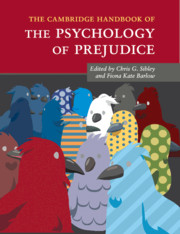Book contents
- Frontmatter
- Dedication
- Contents
- List of Figures
- List of Tables
- Notes on the Contributors
- Part I General Theoretical Perspectives
- Part II Prejudice in Specific Domains
- 11 Understanding the Nature, Measurement, and Utility of Implicit Intergroup Biases
- 12 Aversive Racism and Contemporary Bias
- 13 Ambivalent Sexism in the Twenty-First Century
- 14 Sexism in Intimate Contexts: How Romantic Relationships Help Explain the Origins, Functions, and Consequences of Sexist Attitudes
- 15 Religion and Prejudice
- 16 Sexual Prejudice: Advances in Conceptual and Empirical Models
- 17 Weight Bias: Prejudice and Discrimination toward Overweight and Obese People
- 18 Prejudice Against Immigrants in Multicultural Societies
- 19 Generalized Prejudice: Old Wisdom and New Perspectives
- Part III Prejudice Reduction and Analysis in Applied Contexts
- Index
- References
16 - Sexual Prejudice: Advances in Conceptual and Empirical Models
from Part II - Prejudice in Specific Domains
Published online by Cambridge University Press: 17 November 2016
- Frontmatter
- Dedication
- Contents
- List of Figures
- List of Tables
- Notes on the Contributors
- Part I General Theoretical Perspectives
- Part II Prejudice in Specific Domains
- 11 Understanding the Nature, Measurement, and Utility of Implicit Intergroup Biases
- 12 Aversive Racism and Contemporary Bias
- 13 Ambivalent Sexism in the Twenty-First Century
- 14 Sexism in Intimate Contexts: How Romantic Relationships Help Explain the Origins, Functions, and Consequences of Sexist Attitudes
- 15 Religion and Prejudice
- 16 Sexual Prejudice: Advances in Conceptual and Empirical Models
- 17 Weight Bias: Prejudice and Discrimination toward Overweight and Obese People
- 18 Prejudice Against Immigrants in Multicultural Societies
- 19 Generalized Prejudice: Old Wisdom and New Perspectives
- Part III Prejudice Reduction and Analysis in Applied Contexts
- Index
- References
Summary
Considerable advances have occurred in the study of prejudice against sexual minorities (e.g., lesbian, gay, bisexual, or transgender individuals) across multiple fields of psychology in recent years. With this growing attention, scholars have proposed more refined and nuanced conceptualizations of sexual prejudice, documented varied ways in which it is expressed, identified multiple underlying predictors, and pointed to emerging issues that require concerted interdisciplinary approaches to address. There is also a substantial literature base documenting discrimination against sexual minorities and its many physical, mental, and behavioral health consequences (Katz-Wise & Hyde, 2012; Meyer, 2003). For the purpose of this chapter, however, we focus on the construct of sexual prejudice itself and seek to provide an understanding of individual factors and social processes that contribute to its development and perpetuation.
Operationalizing Sexual Prejudice
Scholars have proposed and used varying terminology for the continually evolving concept of sexual prejudice as it is now understood; of these terms, “homophobia” (largely attributed to Weinberg, 1972) has been the most enduring and widely used in research and popular culture. Herek (2004) provided a rich review and critique of these terms, with an emphasis on homophobia, and considered the historical and societal context in which this term first originated and was later revised. In his critique, Herek noted important limitations to the term “homophobia,” including (a) it rarely refers to an intense, irrational fear of sexual minorities; (b) it is framed through the lens of psychopathology but is not meant as a diagnosis; (c) it has inadequately reflected the role of broader social norms and processes in shaping individuals’ attitudes; (d) more recently its operationalization has become diffuse as a consequence of being applied to a rather large range of ideas; and (e) it is often considered synonymous with prejudice toward gay men specifically rather than sexual minorities more expansively. Consequently, although many researchers use the term “homophobia” to capture a range of interrelated concepts (e.g., individuals’ negative attitudes toward non-heterosexuals, discriminatory social policies or institutions), it has steadily been replaced by terms such as “sexual stigma,” “heterosexism,” and “sexual prejudice,” which we describe next.
Sexual stigma may be defined as the collective belief among members of society that non-heterosexual identities, feelings, or behaviors are wrong and inferior to heterosexual identities, feelings, or behaviors (Herek, 2004).
- Type
- Chapter
- Information
- The Cambridge Handbook of the Psychology of Prejudice , pp. 371 - 391Publisher: Cambridge University PressPrint publication year: 2016



